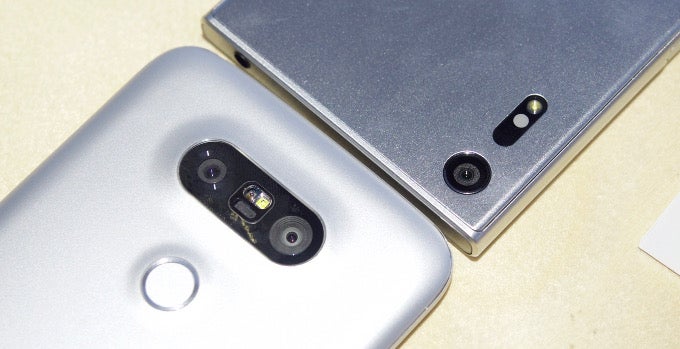Smartphone tech has a way of snowballing; someone introduces a new feature to mainstream audiences, another couple devices pick it up, and before you know it, it's practically everywhere. Back in 2014,
LG brought a laser-assisted auto-focus to its G3. Now, lasers automatically get you cool points in tech circles, but this was no simple gimmick, and the use of a laser measurement system not only helped speed up focus times but measure subject distance with impressive precision. In the years since, we've seen similar features pop up all over the place, and now it's time for Sony to add a laser to one of its own phones, as
the brand-new Xperia XZ counts a laser-assist among its many camera features.
Of course, LG's come a long way since its G3 days, too, so we stopped by Sony's IFA 2016 press event today to see how the Xperia XZ looked when stacked up against LG's own 2016 flagship,
this year's earlier G5.
What smartphone manufacturer wouldn't want to have a phone with the hottest camera around, but everyone approaches that goal from different directions. For a few years now, the idea of multiple primary cameras has been kicking around, and with the G5, LG pairs a standard lens with a second sensor tied to a wide-angle lens. And of course, laser auto-focus is back.
Sony's approach to camera dominance is a bit more complicated, combining several disparate technologies. There's the laser auto-focus, sure, but that's just one part of this puzzle; we've also got a multi-axis motion-compensation system to try and keep exposures crisp, as well as an advanced color-measurement sensor that combines readings of both visible and infrared light to adapt and balance image tones for each individual scene.
When it comes to raw pixel county, Sony's got a clear advantage, with 23MP and 13MP sensors to the G5's 16MP/8MP and 8MP front-facer. Of course, it takes more than a high number of pixels to put together a great-looking image, and we'll want to spend the time doing a proper shot-for-shot comparison before coming to any conclusions about superiority here.
Going head-to-head with other specs, we see both models evenly matched with their Snapdragon 820 chips, while LG pulls ahead with its 4GB of RAM to Sony's 3GB. In other areas Sony enjoys a minor lead, like with the extra 100mAh its battery has above LG's. Screen sizes are similar, as 5.2 and 5.3 inches for Sony and LG respectively, but while Sony is comfortable staying with 1080p for the moment, LG has long ago graduated to quad HD 1440 x 2560.
LG
should be able to demand a lot of attention with its
support for modular hardware, something Sony just can't touch with the Xperia XZ. And while we have to give LG credit for being the first big name to give such a concept a shot, the G5's “friends” were a big swing-and-a-miss – Sony doesn't have anything to fear here. Instead, that modular support might actually hurt the G5, as it means that LG couldn't build a waterproof phone. The XZ, by contrast, is rated to be IP65/68 water-resistant.
Just as was the case
with the Xperia XZ and Samsung Galaxy S7, we see phone design go in two wildly different directions here, with the XZ once again coming off as the boxier, more formal-looking model. And though the two can't agree on things like fingerprint scanner placement (assuming the XZ even has it available in your market), they're on the same page for subjects like microSD support, internal storage (with a 32GB base level), and the use of metal alloys for their phones' bodies. We also see both supporting reversible USB Type-C, as Sony joins the growing club of manufacturers making the transition.
Battery life is super-important to heavy smartphone users, not just in being able to quickly recharge their batteries for another day of operation, but in how those batteries hold up over the long term. LG takes a simple, but very effective approach to the issue: when your G5's battery needs to go, you can just pull it out and pop a new one in. For Sony, with its non-removable battery, the situation is a little more complicated, but the Xperia XZ still manages to prolong its battery's effective lifespan through some smart charging tech that avoids holding the battery at 100% charge longer than you absolutely need it.
These two phones really show us that there's more than one way to solve any given problem, with LG and Sony each bringing their own expertise to smartphone engineering. We can't wait to take an even closer look and see just how fierce competition this new Sony Xperia XZ ends up proving to be for this year's existing flagships – the LG G5 included.














Things that are NOT allowed: